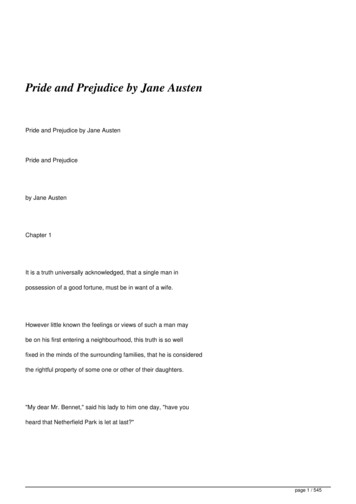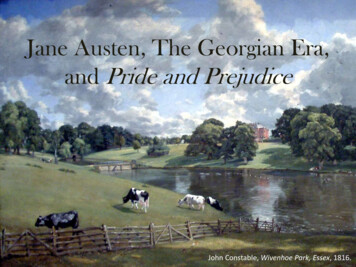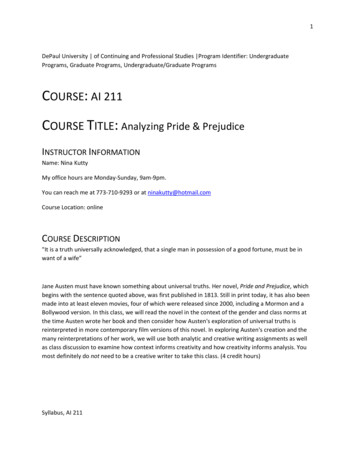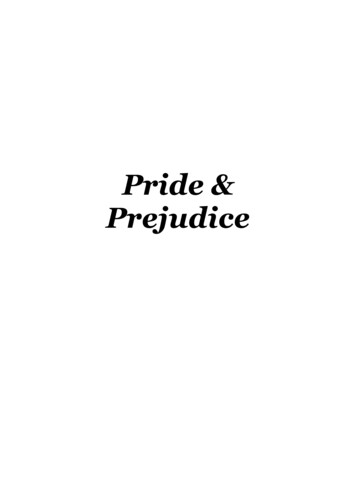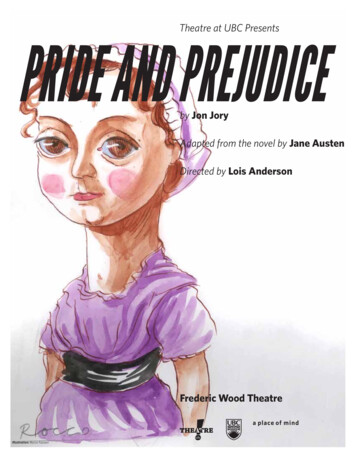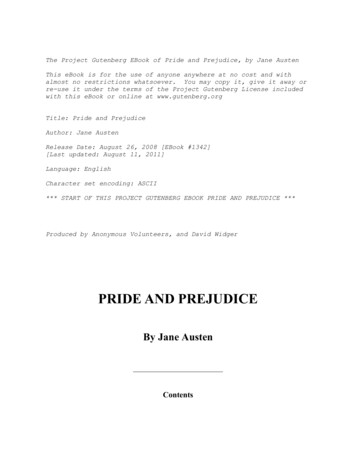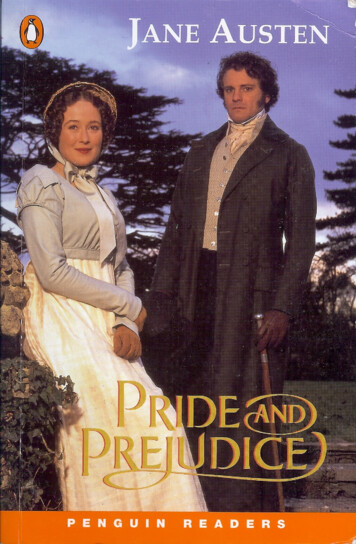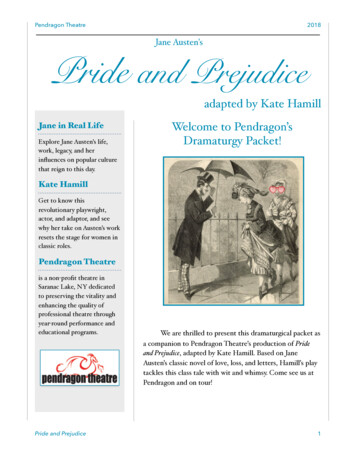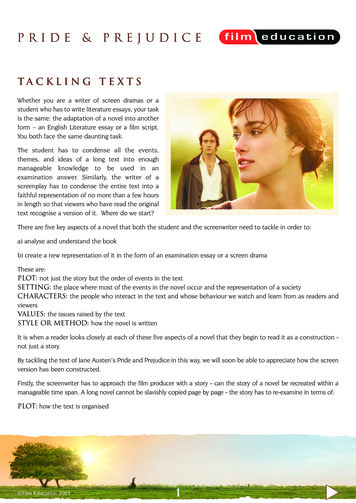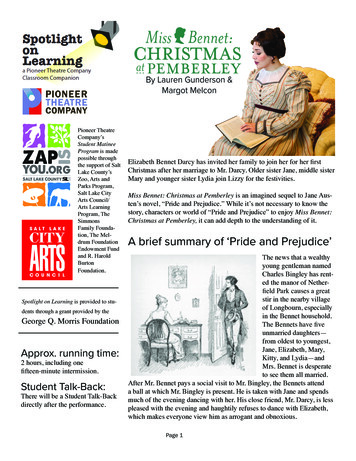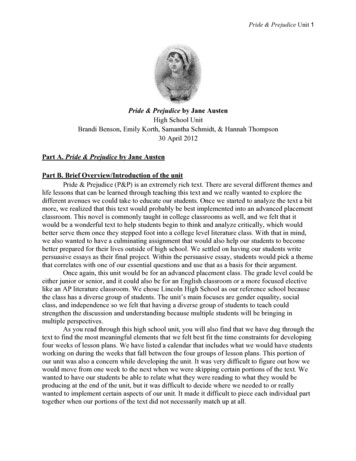
Transcription
Pride & Prejudice Unit 1Pride & Prejudice by Jane AustenHigh School UnitBrandi Benson, Emily Korth, Samantha Schmidt, & Hannah Thompson30 April 2012Part A. Pride & Prejudice by Jane AustenPart B. Brief Overview/Introduction of the unitPride & Prejudice (P&P) is an extremely rich text. There are several different themes andlife lessons that can be learned through teaching this text and we really wanted to explore thedifferent avenues we could take to educate our students. Once we started to analyze the text a bitmore, we realized that this text would probably be best implemented into an advanced placementclassroom. This novel is commonly taught in college classrooms as well, and we felt that itwould be a wonderful text to help students begin to think and analyze critically, which wouldbetter serve them once they stepped foot into a college level literature class. With that in mind,we also wanted to have a culminating assignment that would also help our students to becomebetter prepared for their lives outside of high school. We settled on having our students writepersuasive essays as their final project. Within the persuasive essay, students would pick a themethat correlates with one of our essential questions and use that as a basis for their argument.Once again, this unit would be for an advanced placement class. The grade level could beeither junior or senior, and it could also be for an English classroom or a more focused electivelike an AP literature classroom. We chose Lincoln High School as our reference school becausethe class has a diverse group of students. The unit’s main focuses are gender equality, socialclass, and independence so we felt that having a diverse group of students to teach couldstrengthen the discussion and understanding because multiple students will be bringing inmultiple perspectives.As you read through this high school unit, you will also find that we have dug through thetext to find the most meaningful elements that we felt best fit the time constraints for developingfour weeks of lesson plans. We have listed a calendar that includes what we would have studentsworking on during the weeks that fall between the four groups of lesson plans. This portion ofour unit was also a concern while developing the unit. It was very difficult to figure out how wewould move from one week to the next when we were skipping certain portions of the text. Wewanted to have our students be able to relate what they were reading to what they would beproducing at the end of the unit, but it was difficult to decide where we needed to or reallywanted to implement certain aspects of our unit. It made it difficult to piece each individual parttogether when our portions of the text did not necessarily match up at all.
Pride & Prejudice Unit 2Another difficulty we faced was finding the direction we wanted to ultimately go with thetext. As mentioned above, this text is very rich and has multiple directions that it can be taken.We did not know what we wanted our students to learn specifically when reading the novel, nordid we know exactly what we wanted them to show at the end that represented theirunderstanding of the text. It proved to make our lesson progression and other aspects of the unitmuch more stressful because we had no clear end in sight to begin with.Ultimately, we would like our students to become aware of changes they see aroundthem. Not only would we like them to become aware, but we would also like them to work onaccepting and promoting change in areas of their lives that they feel need to be justifiablychanged. We want our students to leave this unit critically thinking about the world around themand how elements like gender and social class play into their views of others. Students should beable to form an opinion and be able to argue why they believe what they believe.Prior to this unit, we envision our students finishing up a unit on persuasive speaking andthe ways that their word choice and delivery can be used as a powerful tool. We will be lookingat several different speakers throughout history and how their speeches promoted some sort ofchange. After this unit, we would like to have our students work on developing their persuasiveessays into a persuasive speech of some kind. This way, students are learning to write topersuade an audience, but can also successfully argue their point through speaking and dialogue.With the knowledge that students will gain from studying persuasive speaking prior to writing apersuasive essay, it should be a easy transition for students to make to move from writing apersuasive essay into putting their essay into speech format.Part C. Understandings/Big Ideas (Long-Term Goals)The Central Understand/Big Idea we want to portray in this unit is recognizing,accepting, and promoting change. The two major State Standards the unit promotes are NE StateStandards 12.1.4. and 12.1.5. State Standard 12.1.4 states, by the end of the twelfth grade,students will analyze literature to identify the stated or implied theme. This standard worksclosely with NE standard 12.1.5. stating, by the end of the twelfth grade, students willdemonstrate the ability to analyze fiction through identifying and applying knowledge ofelements and literary techniques. According to Smagorinsky, “the destination is the ultimatelearning that you anticipate for students as a result of their experiences during the unit” (113).These state standards are the destinations we want our students to arrive at by the end of the unit.Once students are able to recognize and accept change, they will begin constructing their ownopinions based on their feelings and thoughts obtained through analyzing Pride & Prejudice. Anindividual’s pride and prejudices affect how they see other people and the world around them.When students are able to understand and accept his/her individual prides and prejudices he/shecan enact change. Enacting change about prides and prejudices, stems into the larger idea ofsocial change, particularly with comparing/contrasting 19th century England with today.In order to clearly articulate the comparisons students needed to see, Pride & Prejudicewas divided into three different themes that related back to the big idea of recognizing,accepting, and promoting change: Pride, Prejudice, and First Impressions; Courtships, Marriage,and Relationships; and Civility, Manners, and Social Class. According to McTighe, “The best
Pride & Prejudice Unit 3questions point to and highlight the big ideas. They serve as doorways through which learnersexplore the key concepts, themes, theories, issues, and problems that reside within the content,perhaps as yet unseen; it is through the process of actively ‘interrogating’ the content throughprovocative questions that students deepen their understanding” (106). By breaking up theessential questions into three separate areas/themes, the meaning/ideas we wanted to portray toour students were more focused and distinct. The essential questions we decided to focus onwere as follows:1. Pride, Prejudice, & First Impressions Do we misperceive/misjudge people--regardless of their status--and is that prejudice? How do we work to overcome our pride and our prejudices? Is it necessary to discard ourpride and prejudices in order to strive for equality? How can we influence others to change their prejudices?2. Courtship, Marriage & Relationships How do the expectations of our gender influence our interactions with others? What does it mean to be independent--as a woman/man? What does it mean to besuccessful as a woman/man? How has the definition of success changed over time? Why is it important to have various types of relationships in our lives? How do ourrelationships with others affect our worth?3. Civility, Manners, & Social Class How do social class and financial expectations affect our judgments? Have we been taught to classify people in society? In what ways? Why were we taughtthis? Is it productive to classify people in this way? Why is it important to recognize the need for manners and civility in our interactions withothers?McTighe states, “Good questions spark meaningful connections with what we bring tothe classroom from prior classes and our own life experience. They can and do recur with profit.They cause us to rethink what we thought we understood and to transfer an idea from one settingto others” (107). All the essential questions chosen for this lesson reflect Regency English withpresent day ideals and events. Connecting Pride & Prejudice with today helps students betterrelate with the characters of the novel. Also, focusing Pride and Prejudice on present day idealsmakes helps take the focus of the feminist theme of the novel. The emphasis is taken off offeminism in order to heighten the interest level of the male students in the class. According toMcTighe, “They (essential questions) should recur over the years to promote conceptualconnections and curriculum coherence. All of the essential questions can be considered inpresent time, and they can be used throughout future curriculum.Recognizing, accepting, and promoting change is an important understanding forsecondary English students to develop because change is constant and never-ending. “A goodeducation is grounded in such lifelong questions, even if we sometimes lose sight of them whilefocusing on content mastery. The big-idea questions signal that education is not just aboutlearning ‘the answer’ but about learning how to learn” (McTighe 108). By learning about
Pride & Prejudice Unit 4change, students will be able to learn how time affects different aspects of society. Changingone’s ideas and prejudices based on analyzing the differences between Regency England andpresent day will help students understand what aspects go into change such as social class,gender, war, marriage, and religion. These thoughts will stimulate metacognition which is “anindividual’s cognition about his/her cognition or ‘knowing about knowing’” (Moreno 214).When students are aware that they are learning, they will realize the meaning associated with aunit.According to Jago, “Students also need books that act as windows. These stories offerreaders access to other worlds, other times, other cultures” (5). Pride & Prejudice is classicaltext that can give students a view of their world before they or even their parents were born.Understanding why changes occurred in the past will help students prepare for change in thefuture and analyze why these changes occurred. Classical texts also help students buildvocabulary. Classical Literature can inspire imagination and build background knowledge forstudents to build on and use in the future. Pride & Prejudice offers students a whole newperspective on class and marriage, two aspects that are ever-changing.Part D. Stage One: Enabling Knowledge and Skills (Short-Term Goals)In the development of our unit, we leaned heavily on the Nebraska State Standards whendetermining what our students will know and be able to do upon completion of Pride &Prejudice and its accompanying projects. We ultimately derived our short-term goals from theNebraska State Standards for Language Arts and Writing. Though many of the standards wouldfit the lessons and projects of our unit, we decided to focus on only the most crucial andinfluential standards. Within the NE State Language Arts Standards/Writing, We decided tofocus on LA 12.2.1 Writing Process: Using all parts of the writing process to play, draft, edit,and publish writing. Within LA 12.2.1, the sub-standards of we're placing a particular emphasison LA 12.2.1.b (Generate a draft by constructing clearly worded and effectively placed thesisstatements that convey a clear perspective on the subject) and LA 12.2.1.d (Provide oral, written,and/or electronic feedback to other writers). We feel that our unit reflects this group of standardswell with the creative fiction essay, "Another Bennet Sister/Brother," the final persuasive essay,the wedding report, and the letter for social change. All of these projects will go through thewriting process, including outlining, drafting, revising, and publishing, to insure that students areeffectively constructing their writing with compelling stylistic measures.In addition to LA 12.2.1, we also decided to focus on LA 12.2.2 Writing Genres: Studentswill write for a variety of purposes and audiences in multiple genres. Within this standard, wefocused our efforts on two sub-standards, LA 12.2.2.b (Write considering typical characteristicsof the selected genre) and LA 12.2.2.d (Analyze models and examples [own and others'] ofvarious genres in order to create a similar piece). Throughout our unit, we are incorporatingnumerous pieces of writing that focus on a variety of genres, audiences, and purposes. Thecreative fiction essay, "Another Bennet Sister/Brother," is a vastly different piece than the finalpersuasive essay, as is the wedding report article and the letter for social change. However, bygiving students experience with multiple genres, audiences, and purposes, students will acquire aunique set of writing skills that will benefit them in future English classes and on standardized
Pride & Prejudice Unit 5testing. Beyond the physical act of writing, LA 12.2.2 also provides opportunities for us to focuson other aspects of writing in greater detail through our in-context grammar lessons that focus onartful dialogue, word choice/imagery, sentential adverbs, the artfulness of prepositional andadjectival phrases. In addition, students will also gain experience using journalistic a style forthe wedding write-up activity, in which they will be modeling a NY Times Lifestyle journalistand his descriptive style. This activity also fulfills the requirements of LA 12.2.2.d by analyzingmodels and examples of various genres in order to create a similar piece. In keeping with thisstandard, we will also be sing the in-context lesson on artful dialogue to model Austen's use ofartful sentences and strategic dialogue in her novel, providing an excellent opportunity forstudents to use mentor texts in the betterment of their own writing.Focusing on the NE Writing Standards, we felt the strongest about including 12.2.3 Bythe end of the twelfth grade, students will revise and edit persuasive compositions. As we chosea persuasive essay as our final assessment, including the proper revision and editing techniqueswas a given with the activity. Furthermore, the persuasive features of the essay lent themselveswell to the big ideas and essential questions of our unit, offering a great feature essay for ourassessment. For the grading rubric and the other various aspects of the persuasive essay, weleaned heavily on the inspiration from the 2007 Advanced Placement test persuasive essayrubric. We felt that the criteria, including thesis & main points, quote selection/integration,organization & style, development, and format/mechanics, matched the ideal standards we heldfor our fictional classroom. As an added bonus, by completing essays to the criteria of thisrubric, students will also experience an A.P. test-like situation and provide insight as to how theycould improve their writing before the actual test. In the culmination of these numerousqualities, we feel that our final assessment features fit well with the both the theme of the unit aswell as the state writing standards.Part E. Stage Two: Assessments, Collected Evidence, & CriteriaSection 1. The type of evidence that we will be collecting over the course of the unit is meant toassess students’ understanding in both an informal and formal way. Our formative assessmentsall serve as scaffolding means to hinge onto our big idea of “change.” This way, students areable to make connections through a multi-dimensional way and critically explore the idea of“change” for themselves. Ultimately, the formal and summative assessment has studentsexemplify to what degree they understand the idea of “change.”Central Understanding of the Unit [see appendix for assignment sheets]: Persuasive Essay on social change-Students will write a persuasive essay on a need for change in order to exemplify thatthey understand the big idea of “accepting, recognizing, and promoting change.” Students willneed to use critical thinking skills in order to make connections with the text and to societytoday. Students will use ethical thinking skills in order to determine if the change is necessarybased on an ethical means. Students will use creative thinking while determining what to writeabout (their choice exemplifies creativity) and what the order of their facts/points does to theirargument. This persuasive essay also meets this standard: LA Standard 12.2.3: By the end of thetwelfth grade, students will revise and edit persuasive compositions.
Pride & Prejudice Unit 6 Ciceronian essay-While not a feature of this unit on Pride & Prejudice, a potential lesson expansion couldexist in the study of the ciceronian essay form. In this activity, students study and demonstratethe use of the ciceronian essay in order to explore different parts of persuasion. Students willwrite a need for change in order to exemplify that they understand the big idea of “accepting,recognizing, and promoting change.” Students will need to use critical thinking skills in order tomake connections with the text and to society today. Also, the different parts of the ciceronianessay makes students think critically about each part they include and what its inclusion does totheir argument. Students will also use ethical thinking skills in order to determine if the changeis necessary based on an ethical means. Students will use creative thinking while determiningwhat they include in each section of the essay and how the juxtapositions form an argument. Comparison/contrast essay.-While not a feature of this unit on Pride & Prejudice, a potential lesson expansion couldexist in the study of the comparison/contrast essay. Students could compare and contrast achange in Regency England to today. The compare/contrast naturally elicits critical thinkingskills, but students also need to go beyond that use critical thinking skills to name why thechanges have happened. Students use ethical thinking skills to determine if the need for changehappened (from Regency England) on an ethical basis and if the need for change should happenon an ethical basis. Students will use creative thinking while determining what to write about(their choice exemplifies creativity) and what the order of their facts/points does to theirargument.Enabling Skills and Knowledge [see appendix for worksheets]: LA 12.1.6.l: Students will extract and construct meaning using prior knowledge, applying textinformation, and monitoring comprehension while reading grade level text. Now/Then worksheet:-Students will build and activate prior knowledge in order to clarify text, deepenunderstanding, and make connections while reading. “Married as a Child”:-Students will extract and construct meaning using prior knowledge, applying textinformation, and monitoring comprehension while reading grade level text. LA Standard 12.2.1: By the end of the twelfth grade, students will write using standard English(conventions) for sentence structure, usage, punctuation, capitalization, and spelling. Students use their “Letter for Change” and turn it in a “Poem for Change” using correctsentence structure, usage, spelling, etc.-Specifically for this unit, students work on using artful prepositional phrases, the
Pride & Prejudice Unit 7specifics of dialogue, word choice/imagery, and sentential adverbs. Students willbe exposed to a variety of sentence structure “tools” that will allow them to writeartfully and more complex while using creative thinking skills. This will requirestudents to use critical thinking skills in order to manipulate certain sentences intoa poem. Students use weekly vocabulary words and are required to write sentences using their“grammar” function for the week.-Students will be required to use certain punctuation, usage, capitalization,spelling, and grammatical features (of the week) to exemplify understanding ofthe vocabulary words as well as the standard English conventions/grammaticalfeature. LA 12.2.2 Writing Genres: Students will write for a variety of purposes and audiences inmultiple genres. Students will complete a Facebook/Email Message about social change.- Students must be able to exemplify their understanding of the idea of “change”and be able to articulate their views on change and how it has an impact onsociety. This letter is meant to be a lower risk opportunity for students to makeconnections between the novel and their lives today, and it serves as a scaffoldingmeans to move them towards the summative assessment (the persuasive essay).This message requires students to use critical thinking skills to relate their idea ofchange back to Pride and Prejudice. Students will also use ethical thinking skillsto determine how ethical the problem stands right now—is there a big call forchange? Students will also need to exemplify creative thinking skills in order todraft the actual letter message. Students will create a wedding Write Up.-A Wedding Write Up for Mr. Collins and Charlotte Lucas’s wedding willchallenge students to recognize the differences between the ideals of marriagetoday and during the 19th Century. Recognizing these changes will causestudents to develop their own ideas about marriage as a society norm and decide ifchange is necessary in order to be content in society. Students will complete the “Another Bennet” Activity.-Adding another Bennet to the novel will stimulate students to think criticallyabout how changes affect a family’s reputations and ideals. The students will beencouraged to structure their characters views about marriage, love, andreputation using their own ideas about how these items have changed over timeand the affects they have on different relationships in the novel. LA 12.2.2.b Write considering typical characteristics of the selected genre Students write a persuasive essay on a call for change.
Pride & Prejudice Unit 8-Students should keep in mind pathos, logos, and ethos. Studentsalso should focus on how their persuasion is logical and what possiblecounter arguments may arise. Students write a narrative.-Students write a narrative on a time that they experienced prejudices and whytheir needs to be change. This narrative must have students keep in mind storytelling elements and produce a product that ultimately “tells a story” that attractsthe reader and has a purpose. LA 12.2.2.d Analyze models and examples (own and others’) of various genres in order tocreate a similar piece Students analyze artful dialogue of Jane Austen.-Students will model Jane Austen’s writing style in order to understand how goodwriters write. They will then take this critical thinking analysis and write twoparagraphs using artful dialogue and explaining the impact it has on their writing.This requires students to use creative and critical thinking skills. Students analyze William Blake’s use of prepositional phrases in poetry.-Students use critical and creative thinking skills to analyze the artfulness ofBlake’s prepositional phrases. Students then write their own poem while usingthese features in order to exemplify their transfer of knowledge—from Blake’sartfulness to their own. LA Standard 12.2.4: By the end of the twelfth grade, students will use multiple forms to writefor different audiences and purposes. Students will write a 3 page, double spaced essay where they state a clear thesisfollowed by an argument or rationale supporting their thesis. Their essay will show theirunderstanding and analysis of Pride and Prejudice.Possible Essay Questions:A. Discuss the importance of social class in the novel, especially as it impacts therelationship between Elizabeth and Darcy.B. Though Jane Austen satirizes snobs in her novels, some critics have accused her ofbeing a snob herself. Giving special consideration to Mrs. Bennet and Mr. Collins, argueand defend one side of this issue.C. Pride and Prejudice is a novel about women who feel they have to marry to be happy.Taking Charlotte Lucas as an example, do you think the author is making a socialcriticism of her era’s view of marriage?D. Giving special attention to Wickham, Charlotte Lucas, and Elizabeth, compare andcontrast male and female attitudes toward marriage in the novel.
Pride & Prejudice Unit 9E. Discuss the relationship between Mrs. Bennet and her children, especially Elizabethand Lydia.F. Compare and contrast the Bingley-Darcy relationship with the Jane-Elizabethrelationship.G. Compare and contrast the roles of Lady Catherine de Bourgh and Mrs. Bennet.-Essays are one of the most common forms of writing assigned in high school Englishclassrooms. The ACTs also have a writing portion where the test taker must write a shortessay about a topic, and the ACTs are often necessary to get into most universities andcolleges in the U.S. Writing essays will also prepare students for college and give them abackground how to articulate themselves through writing. This writing assignment fillsthe NE Writing State Standard 12.2.4. because it requires students to write using astandard form of writing while keeping in mind their audience. Jane Austen did not only write novels and prose; she also writes poetry. Although herpoetry did not get as much attention as her novels, Austen used many of the sameconcepts of love, marriage, and pride in her poetry. Below is her poem “Happy theLab’rer.” Students will analyze the poem keeping in mind the same themes seen in Prideand Prejudice. Then, the students will be assigned to write a poem about pride orsomeone who is proud. This poem can either be a positive poem about a time in their lifewhen they or someone who is very close was proud, or the poem can take a moreempathetic “darker” side and describe how pride can cause negativity or failure. Thepoem must be at least 20 lines long and contain different literary elements, artful sentencestructure, and descriptive word choice. Students will then construct an author’s notedescribing what their poem means and why they chose to write about the topic they did.They also need to include the audience they were writing to whether that be tothemselves, the teacher, or an outside source.Happy the Lab'rerJane AustenHappy the lab'rer in his Sunday clothes!In light-drab coat, smart waistcoat, well-darn'd hose,And hat upon his head, to church he goes;As oft, with conscious pride, he downward throwsA glance upon the ample cabbage roseThat, stuck in button-hole, regales his nose,He envies not the gayest London beaux.In church he takes his seat among the rows,Pays to the place the reverence he owes,Likes best the prayers whose meaning least he knows,Lists to the sermon in a softening doze,
Pride & Prejudice Unit 10And rouses joyous at the welcome close.This writing activity fulfills NE State Standard 12.2.4. because students are using a differentform of writing then they previously had been using to express their ideas. The students willneed to keep in mind their audience and articulate what audience they chose and why. Poetry isa form of writing that allows more creative freedom than a more structured form of writing suchas a narrative, essay, or persuasive piece. NE State Writing Standard 12.2.5 By the end of twelfth grade, students will demonstrate theability to use self-generated questions, note taking, summarizing, and outlining while learning. Students will complete “double entry journals.”-The double-entry journal format is an essential way for students to trackimportant quotes in the novel and critically relating the quote’s meaning to thetext, themselves, and other world connections. By using this metacognitiveapproach, students will be able to track and analyze their own thinking processwhile simultaneously retaining more textual information. Students will complete the “First Impressions” activity-In this activity, students will be analyzing various judgments that they makebased on the appearance of gender, economic status, and other social standards.Students will then be asked to critically analyze these judgments in order touncover and examine any existing prejudices. This opening activity will allowstudents to become familiar with the term “prejudice” and its use in multiplecontexts; many students may consider prejudice to stem primarily from racialdifferences, where as in Pride & Prejudice the term is explored at length incontexts varying from social status to expectations of gender. After discoveringtheir prejudices, students will create self-generated questions to facilitate theovercoming of their judgments and share them in a class discussion, solidifyingthe concept through metacognition and critical thinking.Section 2. To assess the central understanding, we have chosen formative and summativeassessments in order to give students multiple chances to prove their understanding of“accepting, recognizing, and promoting change” and for us teachers to assess how productive ourteaching has been. Ultimately, between the ciceronian essay, persuasive essay, andcompare/contrast essay, we chose the persuasive essay for this unit’s summative assessmentbecause we feel it is age appropriate and it fits into our goal of having AP students craft anargument about change that is supported by evidence and that is connected to the novel. We alsofeel this persuasive essay assessment makes students socially aware of problems in their societythat may need to be changed, while using Pride and Prejudice as the basis for this argument.The reading of Pride and Prejudice makes students understand the call for change in the noveland how change of perceptions does occur in society. Students must be able to demonstrate, and
Pride & Prejudice Unit 11most i
Pride & Prejudice Unit 1 Pride & Prejudice by Jane Austen High School Unit Brandi Benson, Emily Korth, Samantha Schmidt, & Hannah Thompson 30 April 2012 Part A. Pride & Prejudice by Jane Austen Part B. Brief Overview/Introduction of the unit Pride & Prejudice (P&P) is an extremely rich text. There are several different themes and
